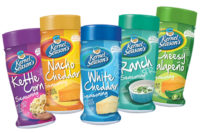Sizing up success: Consumers crave packaging size variety

Not too long ago, grocers offered little variety in packaging sizes. Shoppers could buy soups in one of two sizes of metal cans; they grabbed milk in gallon and half-gallon jugs or quart cartons; and they reached for juices in multi-serving bottles or kiddie-sized juice boxes.
Now, however—thanks to U.S. consumers’ evolving lifestyles and tastes—size matters. Portioned packages of stocks and broths and single-serve packages of juices and energy drinks stand shoulder to shoulder with jumbo-sized versions and many sizes in between.
Why such range? Busy schedules and the distinctive needs of different generations are influencing the container sizes shoppers want and need. In turn, brands can profit by understanding the forces shaping these shifts and taking them into account when planning product concepts.
Changing households, changing needs
Changes in packaging size variety mirror the changing profile of the American household. U.S. Census Bureau data tell us fewer people are living in the average home. The number of people in one-person households rose from 17% to 27% from 1970-2012; this means more heads of households are feeding just themselves, so smaller containers with fewer servings meet their needs.
Family sizes are also shrinking. The most recent census tells us the number of households with children and only one adult rose from 11% in 1970 to 18% in 2012. U.S. families headed by a single parent, according to a 2013 Pew Center report, have tripled since 1960. Further, historically low U.S. birth rates are likely “here to stay, even if some of the recession-induced decline reverses,” notes Brookings Institution analysis.
Take the lower number of people in the average U.S. household and factor in increasingly hectic schedules, and the need for different food and beverage sizes becomes more understandable.
Generations have different needs
In addition to changing households, generational differences are impacting shopping behavior and product sizes. A look at consumer habits and preferences sheds light on what they want and need:
Young consumers: Millennials, the youngest heads of households, are more likely than older shoppers to reach for convenience products, according to research from Brand Amplitude. Only about 25% of Millennials have children; many live alone. They choose single-serve cartons, heat-and-eat foods and other items in smaller packages, a trend that plays into their need to have exactly what they want without having to compromise: whether that means flavors, spice levels, calorie counts or ingredient exclusions like gluten or peanuts. Millennials also are helping drive the “24/7” trend, with consumers constantly connected and busy, frequently foregoing meals in favor of snacks. Attention is diverted from mealtimes with others to computer and smartphone time, and they reach for single-serve products with greater frequency than before.
Middle consumers: Generation X, the group between Millennials and their Boomer parents, cooks an average of 10 meals a week, often augmenting homemade fare with packaged broths, vegetables, sauces and other goods. They appreciate multi-serving cartons, with recloseable tops that preserve unused portions for later. This cohort now has children, from babies and toddlers in Generation Alpha to Gen Z grade-schoolers. Their carts are filled with a mix of container sizes, including single-serve juice cartons for school lunches or snacks and products like soup and almond milk in larger sizes that provide nutritious fare and economical solutions.
Older shoppers: Baby Boomers downsizing to smaller households mean a shift in preference from massive “family-size” containers designed for economy of scale to smaller multi- and single-serve sizes. These serving options allow each adult to have a custom experience, from either a flavor or nutritional standpoint, or in some cases in response to health concerns. Research from IRI suggests food and beverage companies should consider the dexterity challenges faced by some consumers in that cohort. To reach these graying shoppers, producers can offer grippable cartons, easy-open caps and other senior-friendly packaging features.
Sizing things up
Grab-and-go currently is the most dynamic package size trend. In one survey, 72% of consumers indicated they expect to ingest food and beverages on the go in coming months, according to market intelligence tracker GfK Ropers Reports Worldwide.
Still, rapid growth in popularity of single-serve, grab-and-go food and beverage products should not move manufacturers and brands to eliminate larger containers. Recent research in the Journal of Consumer Psychology on package size, perceived quality and price perceptions finds that not all consumers prefer bite-size packaging. A producer might be smart to ramp up production of single-serving packaging but keep multi-serving packages on shelves.
If small containers are surging in popularity, why do larger containers still hold sway?
The percentage of annual food spending allocated to meals enjoyed away from home climbed to more than 43% as of 2012, but that means the bulk (57%) still covers items consumed at home.
Millennials are more budget-minded than older generations—market intelligence agency Blueberry finds about 30% of consumers in that cohort maintain a formal budget, compared with 22% of Gen X and 17% of Boomers. For budget-minded consumers, economical multi-serve containers could hold greater appeal.
Bottom line: Manufacturers and brands should consider a mix of smaller and larger containers for their lines. Different sizes complement each other; a consumer who reaches for a single-serve carton of chilled milk from the convenience store on her way to work is likely to grab a larger carton of the beverage on the way back home. In this way, different sizes can act as brand boosters, carrying shoppers from one product offering to another—which can increase a company’s sales across all of its packaging sizes.
 Suley Muratoglu, vice president, Marketing & Product Management, Tetra Pak Inc. U.S. & Canada, currently runs the company’s presence in core categories, including dairy, beverage and food. Further industry insights from him can be found at www.doingwhatsgood.us. Tetra Pak (tetrapakusa.com) is the world's leading food processing and packaging solutions company.
Suley Muratoglu, vice president, Marketing & Product Management, Tetra Pak Inc. U.S. & Canada, currently runs the company’s presence in core categories, including dairy, beverage and food. Further industry insights from him can be found at www.doingwhatsgood.us. Tetra Pak (tetrapakusa.com) is the world's leading food processing and packaging solutions company.
Looking for a reprint of this article?
From high-res PDFs to custom plaques, order your copy today!







